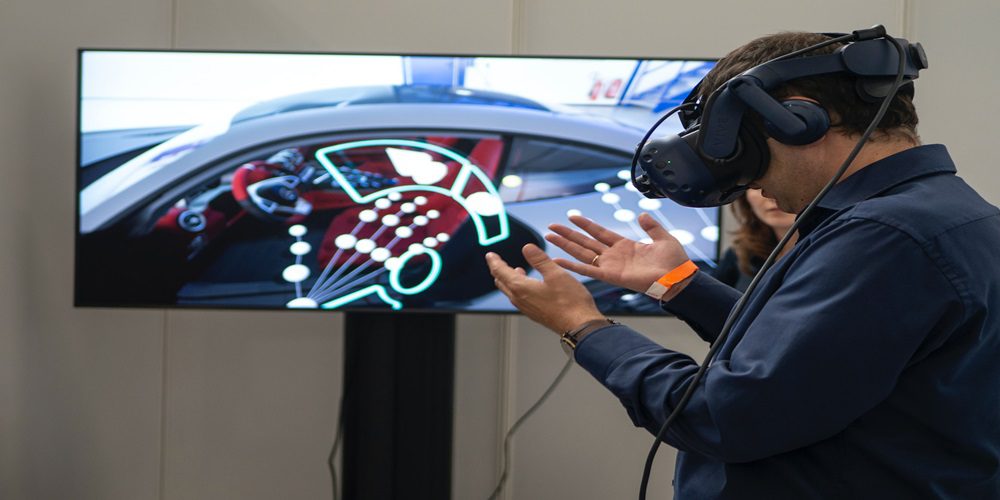Welcome to the future, where reality is about to get a whole lot more extraordinary! Augmented Reality (AR) has come out of the realm of science fiction and into our everyday lives, promising to revolutionize the way we experience and interact with the world around us. From transforming how we shop, learn, travel, entertain ourselves, and even socialize – AR technology is set to reshape our existence by 2024. Get ready to dive into an exhilarating journey where imagination merges seamlessly with reality as we delve into how augmented reality will redefine our daily routines in ways unimaginable just a few years ago.
Introduction to Augmented Reality (AR)
Augmented Reality (AR) is a technology that has been rapidly gaining popularity in recent years and has the potential to revolutionize the way we interact with our surroundings. It combines computer-generated images, videos or other digital content with real-world environments in real-time. This creates an immersive and interactive experience for users unlike any other.
The concept of AR may seem like something out of a sci-fi movie, but in reality, it has already been incorporated into many aspects of our daily lives. From mobile apps to gaming and even advertising, AR has made its mark as a groundbreaking technology that is here to stay.
So what exactly is augmented reality? In simple terms, it overlays digital information onto the physical world through various devices such as smartphones, tablets, smart glasses or projection systems. AR is often confused with virtual reality (VR), but they are two distinct technologies – where VR immerses the user in a completely virtual environment, AR enhances the existing environment by adding digital elements to it.
How AR is Currently Used in Everyday Life
Augmented reality (AR) has come a long way from being simply a concept in science fiction movies to becoming a part of our everyday lives. With the rapid advancements in technology, AR is now more accessible and integrated into various industries and applications. From gaming and entertainment to education and healthcare, AR has already made its mark on how we perceive and interact with the world.
Here are some examples of how AR is currently used in our everyday lives:
1. Mobile Applications:
One of the most widely used applications of AR is in mobile devices. With the help of cameras and sensors on smartphones, developers have created many augmented reality apps that enhance our daily experiences. For instance, navigation apps use AR to overlay information about directions on real-time images captured by phone cameras, making it easier for users to navigate their surroundings.
2. Social Media Filters:
Another popular use of AR in mobile applications is through social media filters. Apps like Snapchat and Instagram use AR technology to create fun and interactive filters that can transform user’s faces or their surroundings into something amusing or comical.
3. Online Shopping:
AR has also revolutionized online shopping by allowing customers to try out products virtually before purchasing them. Many online retail brands have integrated AR features into their websites or apps, enabling customers to see how furniture would look in their home or try on makeup without physically trying them on.
4. Education:
In the field of education, teachers are using AR tools as an innovative way to engage students better and make learning more interactive. With AR, students can explore complex concepts in subjects like science and history by visualizing them in 3D models and animations.
5. Gaming:
AR has transformed the gaming industry with apps like Pokemon Go, which uses real-world locations as part of gameplay. These games blur the line between fantasy and reality, creating an immersive gaming experience for users.
6. Healthcare:
In the healthcare industry, AR is used for medical training and simulations, allowing medical students to practice procedures on virtual patients before working on real ones. AR is also helping doctors during surgeries by providing them with real-time information and guidance through AR overlays.
7. Advertising:
With the help of AR, advertisers are now able to create more engaging and interactive campaigns that bring products to life in front of potential customers’ eyes. Through AR technology, ads can be placed in physical spaces or objects that users can interact with using their mobile devices.
Advancements in AR Technology
Augmented reality (AR) technology is rapidly advancing, and its potential to revolutionize everyday life is becoming increasingly apparent. Through the use of advanced computer vision, depth sensing cameras, and motion tracking technologies, AR offers a unique user experience by overlaying virtual objects onto the real world in real-time. In this section, we will delve into some of the major advancements in AR technology that have paved the way for its widespread adoption.
1. Advanced Hardware Capabilities:
One of the main factors driving the advancements in AR technology is the development of more powerful and compact hardware devices. With smaller sensors that can capture high-quality images and faster processors capable of handling complex calculations, AR devices are now capable of delivering a seamless and immersive experience to users. For instance, devices like Microsoft’s HoloLens 2 and Magic Leap One are packing a range of sensors such as depth-sensing cameras, motion tracking cameras, microphones and speakers all within a lightweight headset.
2. Improved Tracking Technology:
One essential component for any AR experience is accurate tracking – the ability to map virtual objects onto real-world surfaces accurately. Significant developments have been made in this area with new algorithms and techniques being developed to enhance object recognition capabilities. This has led to more precise mapping of surfaces with better understanding between real-world objects’ distance and positions. As a result, users can interact with virtual objects more naturally without experiencing any disorientation or lag.
3. Expanded Field-of-View (FOV):
Early versions of AR headsets had a limited field-of-view, which meant that the virtual objects were only visible in a small portion of the user’s view. However, recent advancements have increased the FOV for AR devices significantly, making the holographic experience more immersive and engaging. For instance, Magic Leap One boasts an FOV of 50 degrees, while Microsoft’s HoloLens 2 offers 52 degrees – a significant improvement over its predecessor.
4. Realistic Rendering:
Another significant development in AR technology is the ability to render high-quality virtual objects that blend seamlessly with real-world environments. The introduction of ray tracing technology and improvements in lighting algorithms have played a crucial role in creating realistic virtual objects that interact realistically with their surroundings. As a result, virtual objects appear more solid and vibrant, giving users a more believable experience.
5. Cloud Computing:
The rise of cloud computing technology has also been instrumental in advancing AR capabilities. By offloading some processing tasks to remote servers, AR devices can access advanced computing power without compromising on size or battery life. This opens up new possibilities for developers to create more compelling experiences without being limited by onboard computing power.
6. AI and Machine Learning:
AR experiences are becoming more personalized and sophisticated thanks to advancements in AI and machine learning technologies . By analyzing user data, AR devices can now anticipate the user’s actions and offer personalized content and interactions tailored to their needs. This is particularly useful in applications like gaming, where AI algorithms can create more immersive and challenging experiences based on users’ skills and preferences.
Predictions for the Future of AR by 2024
The past decade has seen a surge in the development and adoption of augmented reality (AR) technology. From mobile apps and video games to industrial training and medical imaging, the potential applications of AR have expanded rapidly. It is no surprise that experts predict AR will continue to revolutionize everyday life in the next few years. Here are some predictions for the future of AR by 2024:
1. Advancements in hardware: One of the biggest barriers to widespread adoption of AR technology has been its requirement for specialized hardware, such as head-mounted displays (HMDs). However, with ongoing advancements in miniaturization, it is expected that HMDs will become smaller, lighter, and more affordable by 2024. This will make them more easily accessible to consumers and businesses alike, leading to an increase in AR experiences.
2. Increased use in education: In recent years, educators have begun exploring how AR can enhance student learning experiences. By 2024, it is predicted that we will see a significant increase in the use of AR technologies in classrooms around the world. With features like interactive models and simulations, students will be able to better understand complex concepts and engage more actively with their learning material.
3. Augmented shopping experiences: As brick-and-mortar stores face stiff competition from online retailers, many are turning to technology to enhance customers’ shopping experiences. By 2024, it’s likely that stores will incorporate AR into their physical spaces to provide customers with a more immersive and interactive shopping experience. For example, shoppers might be able to try on virtual clothing or test how furniture looks in their homes before making a purchase.
4. AR for remote work: In recent years, remote work has become more prevalent, and the COVID-19 pandemic has only accelerated this trend. AR technology can help bridge the gap between remote workers and their colleagues by providing virtual meeting spaces, shared whiteboards, and other collaborative tools. By 2024, it’s expected that AR will become an essential tool for remote teams.
5. AR glasses as a smartphone replacement: Smartphones are currently the primary device used to access AR experiences. However, by 2024, it is predicted that AR glasses will become powerful enough to replace smartphones altogether. With hands-free functionality and constant display in front of the user’s eyes, AR glasses will enable seamless integration of digital information into our daily lives.
Potential Impact on Industries such as Education and Healthcare
Augmented reality (AR) is a rapidly growing technology that has the potential to revolutionize various industries, including education, healthcare, and retail. This emerging technology uses computer-generated images and sounds to enhance the real-world environment, making it a powerful tool for improving everyday life experiences. In this section, we will explore the potential impact of AR on these three industries.
1. Education:
Augmented reality has immense potential for transforming the way students learn by providing an immersive and interactive experience. With AR, students can visualize complex concepts in 3D models or animations, making learning more engaging and effective. It also enables teachers to create personalized learning experiences based on each student’s needs and learning style.
AR can also bridge the gap between virtual and physical learning environments by bringing virtual objects into the real world. For example, a history teacher can use AR to recreate ancient civilizations or historical events in their classroom as if they were happening in real-time. This would provide students with a more authentic and engaging learning experience.
Moreover, AR has tremendous potential for promoting inclusive education by catering to students with special needs or disabilities. It can offer visual cues or audio instructions that make it easier for them to understand complex topics.
2. Healthcare:
Another industry that stands to benefit greatly from augmented reality is healthcare. The technology has already been used successfully in medical training programs where medical students can practice surgical procedures using AR simulations before operating on real patients.
In addition to training young doctors, AR can assist experienced physicians in performing complicated surgeries by providing real-time guidance, translating medical data into visual aids, and displaying patient information in surgeons’ field of view. This can improve the accuracy and efficiency of surgeries, ultimately benefiting patients.
AR can also be used for remote consultations and diagnoses. With AR-enabled devices, doctors can virtually examine patients from a distance, reducing the need for in-person visits. This is particularly useful in cases where patients have mobility issues or live in remote areas with limited access to healthcare facilities.
Possible Benefits and Drawbacks of Widespread AR Use
Augmented reality (AR) technology has been gaining momentum in recent years, and it is becoming increasingly integrated into our daily lives. From mobile apps to smart glasses, AR is transforming the way we interact with the world around us. As this technology continues to evolve and become more widespread, it’s important to consider both its potential benefits and drawbacks. In this section, we will explore these possible outcomes of widespread AR use.
1. Benefits of Widespread AR Use:
a. Enhancing User Experience: One of the biggest advantages of using AR in everyday life is its ability to enhance user experience. By merging digital information with real-world surroundings, AR creates a truly immersive experience for users. For example, through AR-enabled mobile apps, users can try on clothes virtually or place furniture in their homes before making a purchase decision. This not only makes the shopping process more convenient but also allows customers to make more informed choices.
b. Increased Efficiency and Productivity: As AR technology improves, it has the potential to streamline tasks and increase productivity in various fields such as education, healthcare, manufacturing, and architecture. Through head-mounted displays or smart glasses, workers can access real-time information and instructions while completing tasks hands-free. This can save time by eliminating the need to stop and refer to manuals or instruction guides.
c. Improved Communication: Another benefit of widespread AR use is its ability to bridge communication gaps between people who may not speak the same language or have different abilities. With translation features embedded into AR apps, users can understand and communicate with others in real-time, breaking down language barriers. Additionally, AR can be used to create interactive learning experiences for those with disabilities or sensory impairments.
d. Remote Collaboration: AR technology also has the potential to revolutionize remote collaboration. With advanced AR tools, teams located in different parts of the world can work together on a project as if they were in the same room. This can save time and resources by eliminating the need for travel, while still allowing for effective communication and teamwork.
e. Entertainment and Gaming: As seen with the popularity of games like Pokémon Go, AR has great potential for entertainment and gaming purposes. By superimposing digital elements onto real-world environments, AR games provide a more engaging and immersive experience compared to virtual reality (VR) games which require complete isolation from surroundings.
2. Drawbacks of Widespread AR Use:
a. Privacy Concerns: As with any technology that collects and analyzes data, there are potential privacy concerns related to widespread use of AR. Since this technology tracks user movements and locations in order to function effectively, it raises concerns about who has access to this information and how it is being used.
b. Addiction/Over-dependence: While AR can enhance user experience and increase efficiency, there is also a risk of over-dependence on this technology. As people become accustomed to relying on AR to complete tasks, they may lose the ability to do them without it. This could lead to a decrease in critical thinking skills and self-reliance.
c. Health Effects: There have been concerns about the potential negative effects of prolonged use of AR headsets, such as eye strain, headaches, and motion sickness. While these issues can be addressed through proper design and regulations, they are still important to consider as AR becomes more widespread.
d. Cost: Currently, many AR devices and tools are expensive, limiting their accessibility and affordability for individuals and organizations. As this technology becomes more mainstream, prices may decrease but there will likely still be a significant cost associated with implementing AR solutions.
e. Technological Issues: As with any technology, there is always a risk of malfunctions or technical glitches that can hinder its effectiveness or disrupt users’ experiences. In everyday life, these issues may be frustrating but in certain industries like healthcare or aviation where accuracy is crucial, it could have more serious consequences.
Ethical Considerations Surrounding AR Implementation
1. Ethical Concerns with AR Implementation:
As with any emerging technology, augmented reality (AR) also raises some ethical concerns that need to be carefully considered before its widespread implementation in our everyday lives. AR is already being used in various fields such as gaming, education, healthcare, and retail. However, as this technology becomes more advanced and integrated into our daily activities, it is essential to address the potential issues that may arise.
Some of the key ethical considerations surrounding the implementation of AR are:
a) Privacy Concerns: One of the primary concerns with AR technology is its potential invasion of privacy. With AR devices equipped with cameras and sensors, there is a risk of personal information being collected without consent or knowledge. For instance, facial recognition software used in AR glasses can capture images and identify individuals without their consent or knowledge. Therefore, it is crucial for companies developing AR applications to prioritize user privacy by implementing strict data protection policies.
b) Misuse of Information: As with any new technology, there is always a possibility for it to be misused for malicious purposes. In the case of AR technology, hackers could potentially manipulate digital overlays or use them as a tool for cyberattacks, causing harm to individuals or organizations. It is necessary to establish strict regulations and security measures to prevent unauthorized access and misuse of AR devices and applications.
c) User Safety: The immersive experience provided by augmented reality can make users unaware of their surroundings while using these devices. This poses a safety concern not only for the user but also for those around them. For example, if a pedestrian is engrossed in an AR experience while walking on a busy street, it could lead to accidents. It is crucial for developers to design AR interfaces that prioritize user safety and provide disclaimers or warnings when necessary.
d) Ethical Design and Representation: As AR becomes more prevalent in society, it is essential to consider the ethical implications of its design and representation. The technology should not perpetuate negative stereotypes or biases of any group or culture. It is crucial for developers to be mindful of cultural sensitivities and diversity while designing AR applications to ensure they are inclusive and respectful.
2. Ensuring Ethical Implementation:
To address these concerns surrounding AR implementation, it is crucial for companies and developers to prioritize ethical considerations throughout the entire development process. This includes:
a) Transparency: Companies should be transparent about their data collection practices and obtain explicit consent from users before using their data in any way.
b) Data Protection: Strict data protection policies should be implemented to protect user privacy and prevent misuse of personal information.
c) User Safety Measures: Developers must incorporate safety measures into the design of AR applications, such as warning signs or prompts that make users aware of their surroundings while using the technology.
d) Cultural and Social Sensitivity: AR applications and devices should be designed with cultural and social sensitivity in mind to avoid perpetuating bias or stereotypes.
e) Regular Ethical Assessments: Companies should regularly conduct ethical assessments of their AR technology and make necessary changes or updates to ensure it aligns with ethical standards.
3. Collaboration between Industry, Government, and Ethics Experts:
Collaboration between industry leaders, government officials, and ethics experts is crucial in addressing ethical concerns surrounding AR implementation. By working together, they can establish regulations and guidelines for implementing AR technology while also ensuring that it benefits society as a whole.
In addition, companies should also involve users in the development process by seeking user feedback and taking their concerns into account. This will help to create a more transparent and ethical approach towards AR implementation.
Challenges and Obstacles for Widespread Adoption of AR
Augmented Reality (AR) has been making significant advancements in recent years, but widespread adoption is still facing several challenges and obstacles. In this section, we will discuss the main hurdles that are preventing AR technology from revolutionizing everyday life.
1. Lack of awareness and understanding: One of the biggest challenges for AR is the general lack of awareness and understanding among the general public. Many people are still unfamiliar with what AR is and how it can benefit their daily lives. This lack of understanding makes it challenging for companies to market their AR products effectively, leading to slow adoption rates.
2. High costs: Another major obstacle for widespread adoption of AR is its high costs. Developing an AR application can be a time-consuming and expensive process, making it difficult for small businesses or individual developers to utilize this technology fully. Additionally, many AR devices such as smart glasses or headsets come with a hefty price tag, making them inaccessible for the average consumer.
3. Limited content availability: While there has been significant progress in developing AR applications and content, there is still a limited amount available compared to traditional media platforms like video games or movies. This shortage of engaging and diverse content may deter people from using AR regularly.
4. Technical limitations: Despite rapid advancements in technology, there are still some technical limitations that hinder the potential widespread use of augmented reality. One such limitation is battery life; most devices have limited battery life when running graphics-intensive applications like AR, which could affect user experience negatively.
5. Social acceptance : AR applications often require the use of a camera, which can make people feel uncomfortable and self-aware, especially in public spaces. This feeling of being watched or recorded could be a significant obstacle for widespread adoption of AR.
6. Privacy concerns: Augmented Reality technology uses personal information and data to provide personalized experiences. This raises privacy concerns among users who may not be comfortable with sharing their data with companies or third-party developers.
7. Compatibility: Another challenge for widespread adoption of AR is compatibility. Many AR apps and devices are only compatible with certain operating systems or devices, limiting its potential reach to a specific audience.
8. Integration challenges: Incorporating AR technology into existing products and services can be complex and challenging, especially for businesses that lack technical expertise or resources. This integration process can also be expensive, making it difficult for small businesses to implement this technology.
9. Regulatory hurdles: The emerging nature of AR technology makes it difficult for governments to keep up with regulations and policies surrounding its use. As a result, there may be legal hurdles that slow down the deployment and adoption of AR in various industries.
10. Education and training: Finally, as AR becomes more prevalent in various industries, there will be a need for educational programs and training to develop the necessary skills to use and develop AR applications effectively. This process can be time-consuming and require significant resources, making it challenging for organizations to integrate AR into their operations.
Conclusion
As technology continues to advance at a rapid pace, it is safe to say that augmented reality will play a significant role in shaping our everyday lives by 2024. From enhancing productivity and simplifying tasks, to providing immersive experiences and entertainment, the potential for AR is endless. With major companies investing in this technology and its increasing accessibility, we can expect to see widespread adoption of augmented reality in various industries and aspects of our daily routines. It’s an exciting time to be alive as we witness the groundbreaking innovations that will ultimately revolutionize how we interact with the world around us through augmented reality.



































